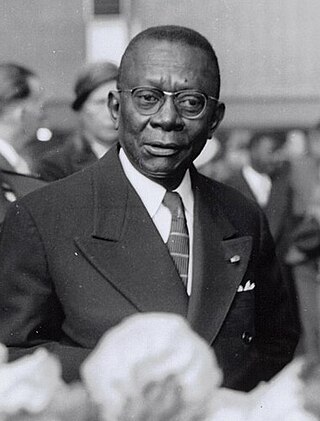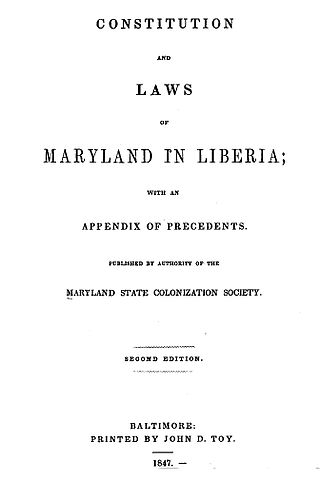
Liberia is a country in West Africa founded by free people of color from the United States. The emigration of African Americans, both freeborn and recently emancipated, was funded and organized by the American Colonization Society (ACS). The mortality rate of these settlers was the highest among settlements reported with modern recordkeeping. Of the 4,571 emigrants who arrived in Liberia between 1820 and 1843, only 1,819 survived (39.8%).

The flag of Liberia or the Liberian flag, sometimes called the Lone Star, bears a close resemblance to the flag of the United States, representing Liberia's founding by former black slaves from the United States and the Caribbean. They are both part of the stars and stripes flag family.

The American Colonization Society (ACS), initially the Society for the Colonization of Free People of Color of America, was an American organization founded in 1816 by Robert Finley to encourage and support the repatriation of freeborn people of color and emancipated slaves to the continent of Africa. It was modeled on an earlier British colonization in Africa, which had sought to resettle London's "black poor".

William Vacanarat Shadrach Tubman was a Liberian politician. He was the 19th president of Liberia and the longest-serving president in the country's history, serving from his election in 1944 until his death in 1971.

Joseph Jenkins Roberts was an Americo-Liberian merchant who emigrated to Liberia in 1829, where he became a politician. Elected as the first (1848–1856) and seventh (1872–1876) president of Liberia after independence, he was the first man of African descent to govern the country, serving previously as governor from 1841 to 1848. He later returned to office following the 1871 Liberian coup d'état. Born free in Norfolk, Virginia, Roberts emigrated as a young man with his mother, siblings, wife, and child to the young West African colony. He opened a trading firm in Monrovia and later engaged in politics.

Montserrado County is a county in the northwestern portion of the West African nation of Liberia containing its national capital, Monrovia. One of 15 counties that comprise the first-level of administrative division in the nation, it has 17 sub political districts. As of the 2022 Census, it had a population of 1,920,914, making it the most populous county in Liberia. The area of the county measures 738.5 square miles (1,913 km2), the smallest in the country. Bensonville serves as the capital.
Ralph Randolph Gurley was an American clergyman, an advocate of the separation of the races, and a major force for 50 years in the American Colonization Society. It offered passage to free black Americans to the ACS colony in west Africa. It bought land from chiefs of the indigenous Africans. Because of his influence in fundraising and education about the ACS, Gurley is considered one of the founders of Liberia, which he named.

The Republic of Maryland was a country in West Africa that existed from 1834 to 1857, when it was merged into what is now Liberia. The area was first settled in 1834 by freed African-American slaves and freeborn African Americans primarily from the U.S. state of Maryland, under the auspices of the Maryland State Colonization Society.

Lott Cary was an African-American Baptist minister and lay physician who was a missionary leader in the founding of the colony of Liberia on the west coast of Africa in the 1820s. He founded the first Baptist church in 1822, now known as Providence Baptist Church of Monrovia. He served as the colony's acting governor from August 1828 to his death in November that year.

William David Coleman was an Americo-Liberian politician. A True Whig Party member, he served as the 13th president of Liberia from 1896 to 1900. Born in Fayette County, Kentucky, United States, he emigrated to Liberia in 1853. In 1877, he was elected to the House of Representatives and served as Speaker of the House of Representatives until 1879. Later he served in the Senate and then as vice president before assuming the presidency when Joseph James Cheeseman died in office.

Alfred Francis Russell was an Americo-Liberian missionary, planter, and politician who served as tenth president of Liberia from 1883 to 1884 after serving as vice-president under Anthony William Gardiner, whom he succeeded as president.

Joseph J. Ross was an Americo-Liberian politician and lawyer who served as the 14th vice president of Liberia from 1898 to 1899. He also served as Attorney General of Liberia under three separate administrations and was thrice elected to the Senate representing Sinoe County and serving as the president pro tempore of the Senate from 1892 to 1896.

Mississippi-in-Africa was a colony on the Pepper Coast founded in the 1830s by the Mississippi Colonization Society of the United States and settled by American free people of color, many of them former slaves. In the late 1840s, some 300 former slaves from Prospect Hill Plantation and other Isaac Ross properties in Jefferson County, Mississippi, were the largest single group of emigrants to the new colony. Ross had freed the slaves in his will and provided for his plantation to be sold to pay for their transportation and initial costs.

The back-to-Africa movement was a political movement in the 19th and 20th centuries advocating for a return of the descendants of African American slaves to the African continent. The movement originated from a widespread belief among some European Americans in the 18th and 19th century United States that African Americans would want to return to the continent of Africa. In general, the political movement was an overwhelming failure; very few former slaves wanted to move to Africa. The small number of freed slaves who did settle in Africa—some under duress—initially faced brutal conditions, due to diseases to which they no longer had biological resistance. As the failure became known in the United States in the 1820s, it spawned and energized the radical abolitionist movement. In the 20th century, the Jamaican political activist and black nationalist Marcus Garvey, members of the Rastafari movement, and other African Americans supported the concept, but few actually left the United States.

Clay-Ashland is a township located 10 miles (16 km) from the capital city of Monrovia in Liberia. The town is in the St. Paul River District of Montserrado County. It is named after Henry Clay — a slaveowner and American Colonization Society co-founder who favored gradual emancipation — and his estate Ashland in Lexington, Kentucky.

The Maryland State Colonization Society was the Maryland branch of the American Colonization Society, an organization founded in 1816 with the purpose of returning free African Americans to what many Southerners considered greater freedom in Africa. The ACS helped to found the colony of Liberia in 1821–22, as a place for freedmen. The Maryland State Colonization Society was responsible for founding the Republic of Maryland in West Africa, a short lived independent state that in 1857 was annexed by Liberia. The goal of the society was "to be a remedy for slavery", such that "slavery would cease in the state by the full consent of those interested", but this end was never achieved, and it would take the outbreak of the Civil War to bring slavery to an end in Maryland.

An independence referendum was held in Liberia on 27 October 1846. The result was 52% in favor, with independence being declared on 26 July 1847.

The Liberian Declaration of Independence is a document adopted by the Liberian Constitutional Convention on 26 July 1847, to announce that the Commonwealth of Liberia, a colony founded and controlled by the private American Colonization Society, was an independent state known as the Republic of Liberia.

Americo-Liberian people, are a Liberian ethnic group of African American, Afro-Caribbean, and liberated Africans. Americo-Liberians trace their ancestry to free-born and formerly enslaved African Americans who emigrated in the 19th century to become the founders of the state of Liberia. They identified themselves as Americo-Liberians.
Emily Harvie Thomas Tubman was an American philanthropist. Born in Virginia, she became a prominent socialite and businesswoman in Augusta, Georgia, and was an early supporter of the Christian Church.
















